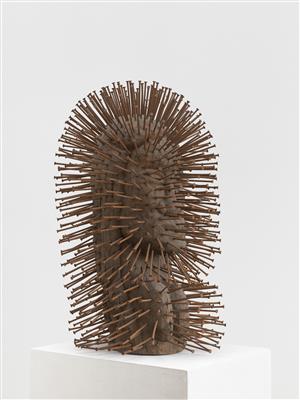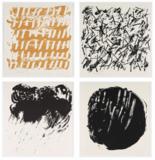Günther Uecker *

(Wendorf 1930 geb.)
Head, 1955/56, signed Uecker, nails on wood, 60 x 34 x 38 cm
This work is registered in the Uecker Archiv with the number GU.56.001 and will be noted for inclusion in the forthcoming catalogue raisonné.
Provenance:
Private Collection, North Rhine-Westphalia – acquired in 1987 directly from the artist’s family
Literature:
Dieter Honisch, Uecker, Catalogue raisonné, Stuttgart 1983, no. 1, p. 169 (with ill.)
Exhibited:
Wuppertal, Kunst- und Museumsverein, Exotisches und Moderne Kunst, 7.4.26.5.1968, no. 41
Hannover, Kestner- Gesellschaft, Günther Uecker, 5.5.-18.6.1972, no. 53
Early work by Günther Uecker: No. 1 in Dieter Honisch’s Catalogue Raisonné
“Uecker’s work can be viewed as ‘art that aims to leave art behind’. Günther Uecker himself does not see art as the end result of his work, but rather as his sphere of influence or as the precondition of his existence.” (Dieter Honisch, Uecker, (catalogue raisonné edited by Harion Haedecke) Stuttgart 1983, no. 1, p. 9.)
Uecker’s works form a unity as a whole. Each work not only stands for itself, but also contains the work to come and simultaneously all past works. Thus, each object both is and isn’t a representation of his oeuvre. Anyone who wants to understand Günther Uecker cannot rely on classical art historical analyses, but must open themselves up to his complex opus. The sum of the works remains located within their form and thus stands in contrast to the dynamic progress of our society. Uecker’s persistence and insistence is a ritual of action that relates to life and reality. The natural repetition of hammering and the use of nails serves as a meditative ritual and transforms his theories into a lived artistic practice. The effect of the relief structure is enhanced by the play of light and shadow. He has created what he calls “nail pictures” for over 50 years. However, Uecker did not just hammer nails into canvases, but also into door frames, chairs, shoes, television sets and record players, among other things.
The work Head, listed as number 1 in Dieter Honisch’s catalogue raisonné, occupies a special position in Uecker’s œuvre on the grounds of its position alone, but it also already motions towards the artist’s characteristic use of commercially available nails.
Uecker often nailed up banal everyday objects. For this work he chose an unusual medium — an old wooden beam, which, according to his self-avowed information, comes from a demolished barn in his homeland. Uecker used it to make a sculpture, the bust of a woman representing his sister Rotraut. In 1953, Uecker left the GDR and moved to West Berlin. He began his studies at the Düsseldorf Art Academy as early as 1955, but returned home to bring his sister Rotraut from Groß Schwansee to the West in 1955, the same year that the sculpture was created.
At first glance, the figure does not necessarily recall the depiction of his sister, but triggered by the confrontation of some Western artists with African tribal art, it allows an association with a German interpretation of indigenous figures. This is particularly indicated by the shaping of the nose and mouth as well as the protagonist’s elongated body. The figure is reminiscent of African nail-fetishes, where the figures are also covered with nails. The nail fetish is primarily intended to protect against evil spells or diseases.
The entire surface of the wooden figure is covered in nails at regular intervals. Depending on the viewing angle, this resulting second layer completely covers some areas of the wooden surface. Thus, the entire head can only be fully grasped through moving around it to different viewpoints.
Ultimately, any affinities to African tribal art in Uecker’s work are not intended. Detecting them is left open to the viewer.
“Other than Uecker, one thinks especially of Yves Klein, of Newman, Rothko, Ad Reinhardt and Beuys. Their works receive their special power not only from the form, but also from the intensity with which they are kept open for all of us and thus accessible to our own feelings. Their special quality lies precisely in this visionary openness, in this questioning search, supported by a strong faith, the inability to give obvious answers and provide ready-made recipes”.
(Dieter Honisch, Uecker, (catalogue raisonné edited by Harion Haedecke) Stuttgart 1983, no. 1, p. 15.)
Irrespective of the interpretation of the work, and despite the characteristic use of commercially available nails, it is clear that the early work “Kopf” is a very special one in the oeuvre of Günther Uecker.
Esperta: Dr. Petra Maria Schäpers
 Dr. Petra Maria Schäpers
Dr. Petra Maria Schäpers
petra.schaepers@dorotheum.de
25.11.2020 - 16:00
- Stima:
-
EUR 300.000,- a EUR 400.000,-
Günther Uecker *
(Wendorf 1930 geb.)
Head, 1955/56, signed Uecker, nails on wood, 60 x 34 x 38 cm
This work is registered in the Uecker Archiv with the number GU.56.001 and will be noted for inclusion in the forthcoming catalogue raisonné.
Provenance:
Private Collection, North Rhine-Westphalia – acquired in 1987 directly from the artist’s family
Literature:
Dieter Honisch, Uecker, Catalogue raisonné, Stuttgart 1983, no. 1, p. 169 (with ill.)
Exhibited:
Wuppertal, Kunst- und Museumsverein, Exotisches und Moderne Kunst, 7.4.26.5.1968, no. 41
Hannover, Kestner- Gesellschaft, Günther Uecker, 5.5.-18.6.1972, no. 53
Early work by Günther Uecker: No. 1 in Dieter Honisch’s Catalogue Raisonné
“Uecker’s work can be viewed as ‘art that aims to leave art behind’. Günther Uecker himself does not see art as the end result of his work, but rather as his sphere of influence or as the precondition of his existence.” (Dieter Honisch, Uecker, (catalogue raisonné edited by Harion Haedecke) Stuttgart 1983, no. 1, p. 9.)
Uecker’s works form a unity as a whole. Each work not only stands for itself, but also contains the work to come and simultaneously all past works. Thus, each object both is and isn’t a representation of his oeuvre. Anyone who wants to understand Günther Uecker cannot rely on classical art historical analyses, but must open themselves up to his complex opus. The sum of the works remains located within their form and thus stands in contrast to the dynamic progress of our society. Uecker’s persistence and insistence is a ritual of action that relates to life and reality. The natural repetition of hammering and the use of nails serves as a meditative ritual and transforms his theories into a lived artistic practice. The effect of the relief structure is enhanced by the play of light and shadow. He has created what he calls “nail pictures” for over 50 years. However, Uecker did not just hammer nails into canvases, but also into door frames, chairs, shoes, television sets and record players, among other things.
The work Head, listed as number 1 in Dieter Honisch’s catalogue raisonné, occupies a special position in Uecker’s œuvre on the grounds of its position alone, but it also already motions towards the artist’s characteristic use of commercially available nails.
Uecker often nailed up banal everyday objects. For this work he chose an unusual medium — an old wooden beam, which, according to his self-avowed information, comes from a demolished barn in his homeland. Uecker used it to make a sculpture, the bust of a woman representing his sister Rotraut. In 1953, Uecker left the GDR and moved to West Berlin. He began his studies at the Düsseldorf Art Academy as early as 1955, but returned home to bring his sister Rotraut from Groß Schwansee to the West in 1955, the same year that the sculpture was created.
At first glance, the figure does not necessarily recall the depiction of his sister, but triggered by the confrontation of some Western artists with African tribal art, it allows an association with a German interpretation of indigenous figures. This is particularly indicated by the shaping of the nose and mouth as well as the protagonist’s elongated body. The figure is reminiscent of African nail-fetishes, where the figures are also covered with nails. The nail fetish is primarily intended to protect against evil spells or diseases.
The entire surface of the wooden figure is covered in nails at regular intervals. Depending on the viewing angle, this resulting second layer completely covers some areas of the wooden surface. Thus, the entire head can only be fully grasped through moving around it to different viewpoints.
Ultimately, any affinities to African tribal art in Uecker’s work are not intended. Detecting them is left open to the viewer.
“Other than Uecker, one thinks especially of Yves Klein, of Newman, Rothko, Ad Reinhardt and Beuys. Their works receive their special power not only from the form, but also from the intensity with which they are kept open for all of us and thus accessible to our own feelings. Their special quality lies precisely in this visionary openness, in this questioning search, supported by a strong faith, the inability to give obvious answers and provide ready-made recipes”.
(Dieter Honisch, Uecker, (catalogue raisonné edited by Harion Haedecke) Stuttgart 1983, no. 1, p. 15.)
Irrespective of the interpretation of the work, and despite the characteristic use of commercially available nails, it is clear that the early work “Kopf” is a very special one in the oeuvre of Günther Uecker.
Esperta: Dr. Petra Maria Schäpers
 Dr. Petra Maria Schäpers
Dr. Petra Maria Schäpers
petra.schaepers@dorotheum.de
|
Hotline dell'acquirente
lun-ven: 10.00 - 17.00
kundendienst@dorotheum.at +43 1 515 60 200 |
| Asta: | Arte contemporanea I |
| Tipo d'asta: | Asta in sala con Live Bidding |
| Data: | 25.11.2020 - 16:00 |
| Luogo dell'asta: | Wien | Palais Dorotheum |
| Esposizione: | online |
Altri oggetti dell'artista
-

Stima:
EUR 1.500,- a EUR 2.000,-
